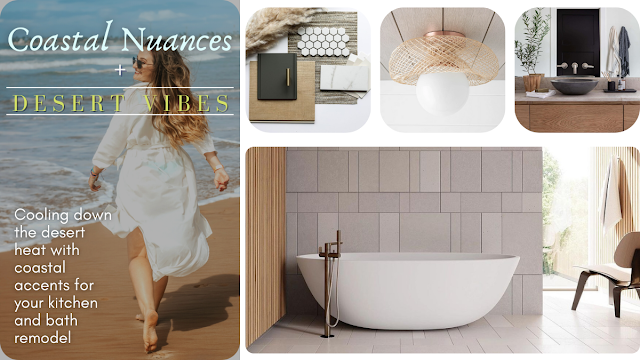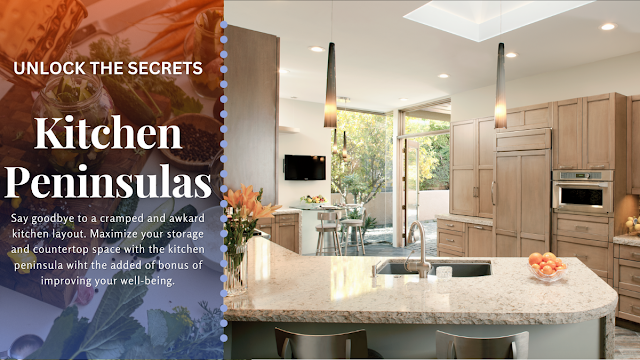How To Blend Desert Design with Coastal Accents
Don't Give Up Your Coastal Memories For Living In The Desert: How to have the best both worlds.
When faced with opposite environments design becomes about finding what is in common. It is very much like unlikely friendships. It is the common grounds and compromises that create a lasting bond. The same can be said and accomplished when combining coastal and desert aesthetics. Not only can it be a beautiful combination but it can help keep you psychologically cool and relaxed through the sweltering Coachella Valley summers.
To accomplish this incredible pairing, Lynn starts with the basics of the design. Layout and architecture are the most important for setting the tone for the rest of the kitchen or bathroom remodel. This doesn't necessarily mean that she is going to move walls (even though that is enough for her) rather she starts with the cabinets. Their color, style and wood species help to set the foundation and create the visual palette. Furnishings like barstools and tub side tables reinforce the architecture.
Tile, textiles and lighting have more flexibility. They can either be neutral speak directly to the architecture or communicate a specific environment. Home accents like mirrors, vases, fine art, sculptures and house plants really help with being specific to trigger pleasing thoughts and memories from the coast or the desert. The best styles to look at for inspiration are Boho, Japandi and Scandi. Japandi and Scandi are the easiest to move into a more sophisticated and luxurious realm without losing the concept. The image below featuring a Native Trails bathtub is a good example:
The kitchen above featuring Wood Mode cabinetry is another great example of being neutral enough to allow room for elements that one might expect to find on the coast or in the desert. Think of saltwater patinaed driftwood or sunbaked branches turned grey in the desert. Consider slab doors keeping cabinet detail to a minimum. Reflective surfaces like the range hood and island lighting can be interpreted as shimmering water or heatwaves radiating off of the desert floor. Glass and water give a sense of levity and hydration.
Natural stone will be a key element to help tie in the beach and the desert. Both sandy environments. One was covered in water ages ago while the other is partnered with water. Quartz is always a number one choice for work surfaces in the kitchen or surfaces that might easily be bombarded by bacteria and viruses in the bathroom (think of where you bathe and proximity to the toilet). Reserve specialty tile for accents. Your kitchen and bath specialist will be able to help you make the best choice based on your lifestyle.
 |
| Ann Sacks Orange County |
Lighting is the next flexible design element. It can be neutral to both environments or speak specifically to one. When keeping it neutral keep in mind the elements in common like heat and ocean waves, architectural lines, and minimalism. Kichler and Feiss are two of Lynn's "go to" companies for lighting that are flexible between coastal and desert design. Hammerton lighting (featured to the side) gives a strong hand to the desert. This could work well if the architecture of the room is starting to feel too coastal. Hammerton designers lean heavily on the masculine with strong architectural lines, alluding to mined crystals. Conversely, Currey and Company (featured below) is an excellent way of softening a strong desert interior with coastal elements. At Currey and Co. one might find a propensity for softer organic lines, natural materials, semi opaque and seeded glass. While both companies are distinct from each other, neither leaves the homeowner feeling out of place.
Japandi, Scandi and Boho color palette for wallcovering is perfect for blending desert and coastal features. Paint has come a long way in durability, quality, and color sophistication. Benjamin Moore is still a long standing favorite because of high performance patented formulas the maintain color quality and don't scuff. They have a history of excellence with sustainability, antimicrobial (for the bathroom in particular) and allergy friendly paint. The added bonus is that when clients use Benjamin Moore paints they support local and small business.
The above mentioned design styles all keep with a strong connection to the calming qualities we experience in nature. Pastel colors and toned accents are signature characteristics of the paint palette. This is the perfect choice for blending coastal and desert environments. Fine art and home furnishings transition seamlessly from room to room with the subtle backdrop of this color scheme.
With the foundation well designed it is time to start adding in the accents that speak specifically to coastal memories and desert living. This is a great time to think about barstools, textiles on banquet and window seats, fine art, sculptures, vases for minimalist plants.
To recap, use cabinetries to establish the tone and create visual architectural interest. Like the cabinets, flooring and countertops should be the intersection between desert and coastal materials. This means that whatever you select should look at home and natural to both the desert and the beach. There is a bit more flexibility with lighting and tile if you want to get a bit more direct about highlighting the coast. When it comes to home accents like fine arts and some furnishings...use as an opportunity to bring in your favorite references to the beach.
It is amazing how two vastly different environments can be combined to give homeowners the best of both worlds.


.png)





.png)

.png)
.png)



Comments
Post a Comment